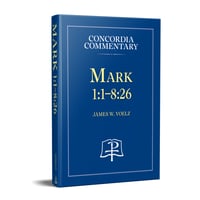The following excerpt is taken from Dr. James Voelz’s commentary on Mark 1:1–8:26, part of Concordia Publishing House’s Concordia Commentary series.
The Theme of Mark’s Narrative
What, then, is the theme of Mark’s Gospel? What is his story about? Consider the features of Mark’s narrative, the characteristics of character and plot and the progress of the story. When we read this Gospel with these features in bold relief, what is it that we see? As many have come to understand, we do see Jesus as the one who walks upon the way of the cross and leads his disciples therein. We see Jesus triumphing through suffering and the cross—saving his life by losing it—and calling his followers to do the same (chapter 8). But that, I would submit, is the penultimate concern of the Gospel of St. Mark. Rather, when one reads this Gospel against what else we know, when we read this Gospel against the foil of depictions from elsewhere—both the kerygma of the early church and the books of the Old and New Testaments, especially the other Synoptic Gospels—then we see a different, a stranger, and a more fascinating picture, a different, strange, and fascinating tale and protagonist indeed. Read literarily, the story of the Second Gospel is the story of ambiguity throughout:
- The protagonist is divine: he casts out demons, who name him the Son of God (chapter 1); he raises the dead (chapter 5), as Yahweh says that he will do (Is 26:19); and he walks on water (chapter 6), as Yahweh does in Job 9:8.
- But he is also a frail human being who gets angry when his opponents resist his work (chapter 3), who is ignorant when his garments are being touched (chapter 5), who cannot do miracles when the people do not believe (chapter 6).
- Moreover, he is a strange and scary human being, for he hides from the crowds, though he has come to preach the Word to them (chapter 1); he dresses down a man whom he has healed after he has had mercy on his plight (chapter 1); and he curses a fig tree even though it was not the season then for figs (chapter 11).
And the plot has a “multiple personality” as well:
- The voice declares from heaven, “You are my beloved Son” (chapter 1; cf. chapter 9); he does miracles (chapters 1–7) and reveals the mystery of God’s kingdom to those who follow him (chapter 4); the crowd is dumbstruck at his deeds, declaring that he has done all things very well (chapter 7).
- Yet his relatives think that he is crazy, as does his closer family, as they attempt to seize him and remove him to their home (chapter 3); the disciples wonder to themselves, “Who, then, is this, that both the wind and the lake/sea obey him?” (chapter 4); and in desolation he utters the “cry of dereliction” on the cross, though he truly is the Son of God (chapter 15).
Simply and succinctly put, in the Second Gospel we see a story hard to follow and a hero difficult to understand. Therefore, we cannot see clearly to believe (cf. 8:22–26). Or as summarized by the Jewish leaders at the cross (15:32): “the Christ, the King of Israel, let him come down now from the cross in order that we may see and believe” (ἵνα ἴδωμεν καὶ πιστεύσωμεν)! In fact, this is exactly what this Gospel will not give: seeing to believe; clear sight to understand; unambiguous evidence to be sure. In this strange and perplexing Gospel, seeing is not believing; on the contrary, seeing follows from believing, not the other way around.
And what is it, exactly, that is to be believed? It is the Word—the Word of him who comes to bring the eschatological reign and rule of God (1:14), whose mission is to give his life as a ransom for many (10:45), indeed, the Word of him whose promises in this story are true and ever sure (see also “Internal Literary Evidence for Ending the Gospel at Mark 16:8,” below). This, then, is what Mark’s Gospel is about: the ambiguity of the evidence, the necessity of believing in the face of such evidence, and the reliability of Jesus’ Word. . . .
The Message of the Gospel of Mark
What, then, is the message of this book? According to our analysis it is this: in this age, the reign and rule of God in Jesus Christ has come in power, but in hiddenness, as it were, in humility and lowliness. The goal of the ministry of Jesus was to serve, not to be served, and to give his life as a ransom for many (10:45). Therefore, the true revelation of the Son of God was at the cross, where he gave his life as that ransom. Jesus promised a revelation of his triumphant self after the cross (14:28), when the disciples would see him (and all things?) clearly. Just as they did not see him clearly immediately, however, and had only his promise, and the Word of the young man, just so we and all Christians do not see him and the kingdom of God fully implemented and manifested now. We do not first see and then believe (as the Jewish leaders would have had it in 15:32); we have only his promise in his Word. It is difficult to be faithful on the basis of the Word alone—the disciples are testimony to that fact! Yet that promise is always sure. There will be a full revelation of the glorious, risen Christ, but for now we can only believe the witness of the Word.
This understanding of the message is appropriate for all recipients of this book who may be thinking along these lines:
We want to be confessors of the faith. We want to be faithful followers in the way. We are not ashamed of the Gospel message of the Christ (see 8:35–38). But it would be so much easier to endure if we could see some proof or sign. If only we had been there when Jesus walked the earth. If only we had been there on that Easter morn. It would be so much easier to endure.
But the answer of the Second Gospel is this: “It was ever thus. If you had been there, it would not have been any easier than it is today. The evidence would have been ambiguous, even with your Lord. What you have is what the disciples and the women had, also on that Easter morning: you have the promise of his Word, a Word that is ever sure.”
 Learn more about the Gospel of Mark in the Commentary by Dr. James Voelz.
Learn more about the Gospel of Mark in the Commentary by Dr. James Voelz.
Footnotes omitted. From Concordia Commentary: Mark 1:1–8:26, pages 54–55, 61 © 2013 Concordia Publishing House. All rights reserved.















